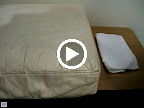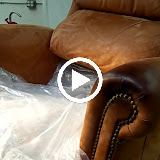The following information set is a critical foundation for understanding the attributes of various types of leather found on furniture and in automobiles. How the leather is processed at a tannery determines its "type." Consumers shopping for leather furniture should know what type of leather they are buying so they can understand what to expect. For the professional leather technician, knowing the leather type is essential to successful leather repair or restoration. Making a mistake in assuming that the leather is one type, when in fact it’s another can have disastrous consequences.
This foundation of knowledge is so important that during Advanced Leather Solutions technician's training program, it's presented in the first lesson. In this post, each leather type is explained with a definition and attributes statement, depicting both the advantages and disadvantages. To learn more go to
www.advleather.com. The web-site is loaded with good information about the care and maintenance of leather furniture, and automobile grade leather.
Finished Leather – Top GrainDefinition: Typically chrome tanned leather representing the epidermis of the hide. It is aniline dyed then a topical pigment coating and clear coating are applied to the surface. These coating represent the color and sheen on the leather.
Attributes: If it’s a top-grain leather, then this is the most durable type of leather as it has the strength of a top-grain and the protection of a urethane coating on the leather.
Advantages: Highly durable, will withstand the rigors of an active household or commercial environment. It is fade and stain resistant. Easy to maintain, this leather will last many years if properly conditioned. This is the correct leather for an active household environment.
Disadvantages: If heavily coated, the leather can feel stiff, and cold.
Finished Leather – Split-hideDefinition: Chrome tanned leather representing the flesh side of the hide that is split away from the top-grain. It is aniline dyed then a topical pigment coating and clear coating are applied to the surface. These coating represent the color and sheen on the leather.
Attributes: Because it’s not the top-grain, this leather lacks durability. It’s an inferior grade leather without the tinsel strength of top-grain, consequently will have a short useful life expectancy. Split-hides are typically heavily pigmented with a heavy urethane clear coat.
Advantages: Affordable. It is fade and stain resistant. The leather is easy to clean.
Disadvantages: It is heavily coated. The leather feels stiff, and cold. Splits do not have durability.
Unfinished, aniline-dyed LeatherDefinition: Chrome tanned top-grain leather. The leather is a called a crust (no finish) with aniline dye infused within the cellular structure of the skin. These are typically the most expensive hides. Only a small proportion of all leather can qualify to be unfinished as they are the hides with the least amount of unsightly hide characteristics like scaring or other anomalies in the leather. A variation is semi-aniline which is aniline dyed leather with a light protective coating.
Attributes: This is soft, supple leather that has a wonder feel, and look. Aniline dyes are translucent. As such, they accentuate the natural beauty of the leather. Because it’ the top-grain, this leather has plenty of physical durability.
Advantages: The initial look and feel of the leather can’t be beat. Warm and inviting, with a wonderful eye appeal this leather represents the best of the best.
Disadvantages: It stains and fades. While it is aesthetically beautiful at the on-set, this leather is vulnerable, particularly in an active household environment. Very difficult to keep maintain. It is very porous and will absorb body oils, etc more readily.
Pull-up or Oil Tanned LeatherDefinition: Chrome tanned top-grain leather. The leather is infused with aniline dye that is “floating” in an oil mix. This means the dye is not bound to the leather. Rather it can move inside the hide, showing areas of color loss when stretched, scratched or scuffed. This leather is often called distressed or referred to as the “bomber jacket look.”
Attributes: The leather has a certain classic aged look. Again, the dyes accentuate the natural beauty of the leather, and because it’ the top-grain, this leather has plenty of physical durability.
Advantages: The look and feel of the leather presents the distressed look that is very popular. The distressing effect helps to conceal stains. Because it’s intended to be distressed, staining and fading are less an issue.
Disadvantages: It does stain and fade. It is very porous and will absorb body oils, etc more readily.
Bi-cast Leather Definition: Chrome tanned split leather or leather composite (like fiberboard) with a very heavy urethane coating. The urethane coating has a dye infused so the color is embedded in the coating, not the leather. It's typically a shiny darker brown in color.
Attributes: This is very low grade leather with little tinsel strength. The primary strength is the urethane coating. While the initial look is appealing, it has a short life expectancy.
Advantages: This is low-end leather that is affordable. It’s easy to clean.
Disadvantages: Very short life expectancy. If it fails, it’s not easy to repair.
SuedeDefinition: Chrome tanned that can be the top grain or split. This is the flesh side of the leather. It represents the nap created when the cow hide is split.
Attributes: This leather has a nap to it that presents a soft appearance and feel. It is aniline dyed with no protection. If it’s the top grain turned inside out, then it will have the durability normally associated with leather. If it’s simply the split, it won’t
Advantages: It offers a warm inviting look. Feels comfortable to the touch with a depth of color only a dye can offer.
Disadvantages: It fades and stains easily. It is very porous and will absorb anything that comes in contact with it. It’s very difficult to clean.
Nubuck or Brushed leatherDefinition: Chrome tanned, aniline-dyed, top-grain that has been sanded to raise the nap.
Attributes: Like suede this leather has a nap to it that presents a soft appearance and feel. It’s aniline dyed with no protection.
Advantages: It offers a warm inviting look. Feels comfortable to the touch with a depth of color only a dye can offer.
Disadvantages: It fades and stains easily. It is very porous and will absorb anything that comes in contact with it. Like suede, it’s very difficult to clean.
Belt leatherDefinition: This is vegetable tanned leather that is highly durable and very strong. In leather furniture it is used as components that are load bearing. Examples would be Wassily and Barcelona (the support straps) chairs.
Attributes: Tough and durable, this leather will withstand years of use and continue to perform as expected. It requires very little maintenance. It's available in both finished (pigmented) or unfinished (raw) forms.
Advantages: Long life expectancy, durable. Requires little to no maintenance.
Disadvantages: Stiff with little suppleness, like a saddle, can be uncomfortable. Unfinished version will stain readily.
There are a number of other leather types from exotics like hair-on hides or stingray, to very delicate leather like lamb, calf or kidskin. These are not normally applied to leather furniture as they lack durability, and are extremely sensitive to staining and fading.
For more information be sure to visit
www.advleather.com.
Copyright 2009, Kevin Gillan




















